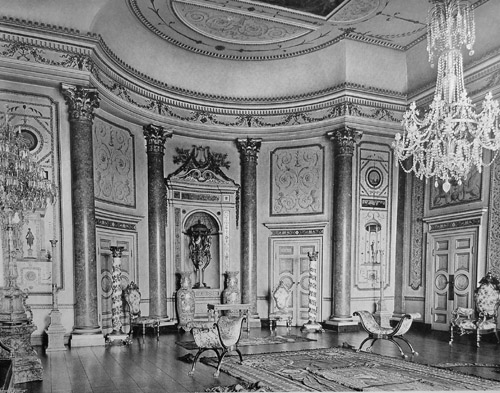
Brief history of the Music Room and its decoration1
The room was built as a pair with the Temple Room to the east of the Marble Saloon. It is about 30 by 40 feet (9 x 12m), was probably designed by Vincenzo Valdrè and not finished until after 1781. With an apse in the centre of the north wall, there are doors at each end of the side walls, though only the northern pair are real – connecting with the Marble Saloon and Large Library – the other two are false doors. The north has within the apse two sets of doors flanking a niche that is surrounded by a decorative frame. There are two un-fluted scagliola Corinthian columns on the corners of the apse and also within it flanking the niche. These imitate Siena marble and are thought to be the work of Domenico Bartoli.

The walls are painted with panels in the form of Grotesques and Arabesques. The chimneypiece is in the centre of the east wall and is of white marble inset with panels of rosso antico marble and with carved decoration of musical instruments in white marble and ormolu. This chimneypiece was sold in 1922 but bought back in 1991; a new mirror above the chimneypiece was made to replace the original one. The plaster ceiling has gilt moulded decoration and seven inset paintings. The entablature is notable for its fine detail, including an unusual row of Greek antefixae along the top. John Phillips, the original gilder, left his signature above the cornice with the date 1778.
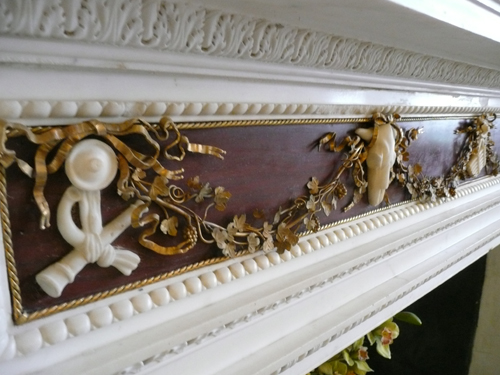
The central painting on the ceiling is circular and is of The Dance of the Hours after Guido Reni and is flanked to the north and south by two rectangular paintings of the four seasons. Between these large paintings are four smaller ones of landscape scenes. All the paintings are believed to be by Valdrè and are based on the themes of music, sacrifice and ceremony.
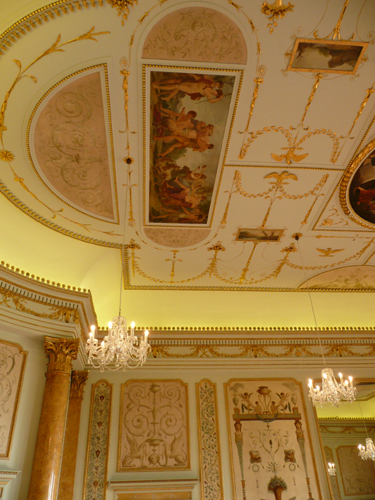
By 1926 the room was used as one of the boys’ houserooms and sometime later had glass screens installed to protect the lower wall-paintings from damage. Since 1963 the room has been restored to its traditional role.
Analysis
The Music Room has been restored as part of the major restoration project funded by the generosity of many donors and grant-making trusts, most particularly the Heritage Lottery Fund, English Heritage, and in partnership with the World Monuments Fund.
The room has been partially decorated on as many as five occasions, although certain surfaces display four schemes and in some cases the original paintwork and gilding survives.
Analysis of the painted surfaces shows that the walls were initially given an interim scheme of soft distemper, which was applied while the plaster was drying out.
The second and third, scheme was an oil paint based on lead white and tinted with tiny amounts of charcoal black, yellow iron oxide and occasional particles of vermilion. The effect seems to have been of a very pale dull greenish colour.
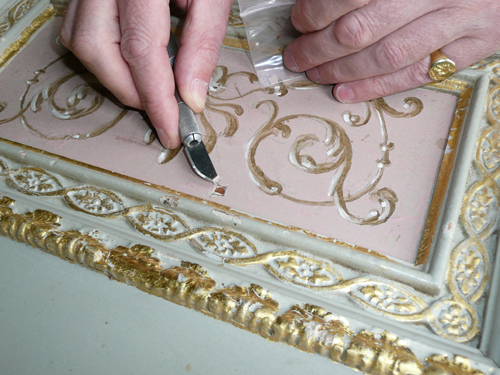
The joinery was originally an off-white and during analysis it was found that the paintwork on the capitals was found to be the original colour.
The painted panels were carefully restored and trials made to select a wall colour that was based on the original yet that sat happily with the eighteenth century decoration.
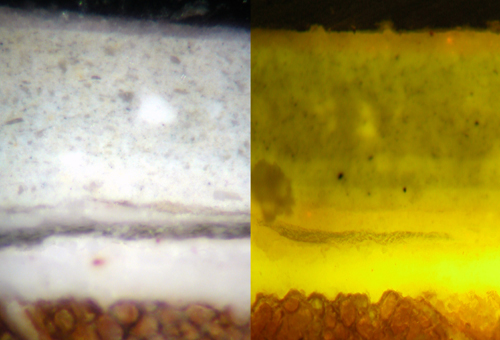
The room had been restored by the brothers Michael and Benjamin Gibbon in the 1960s and evidence of their work was found on the doors. In the photomicrograph above the original lead-based scheme can be seen and above this is one based on the pigment titanium dioxide. It will be noticed that the second scheme does not fluoresce as much as the lead paint does under UV light. It will also be seen that it was applied in three coats. As this pigment was introduced in the 1960s it is thought that this scheme dates from the Gibbons’ restoration.
Notes
1 Source Wikipedia; Michael Bevington. Stowe House. Paul Holberton Publishing. 2002 and a study of the North Hall prepared by Hettie Dix of the Stowe House Preservation Trust 2012.
Here is a slideshow showing the sampling of the doors in the Music Room:
Here is a short film clip made by the World Monuments Fund, who have been instrumental in fundraising for the restoration of Stowe:
The Stowe House Preservation Trust was founded in 1997 in order “to restore and preserve Stowe House for the benefit of the nation and the public.” The school remains as a tenant and the house is opened to the public on more than 200 days per year.
View Larger Map











No comments yet. Be the first!